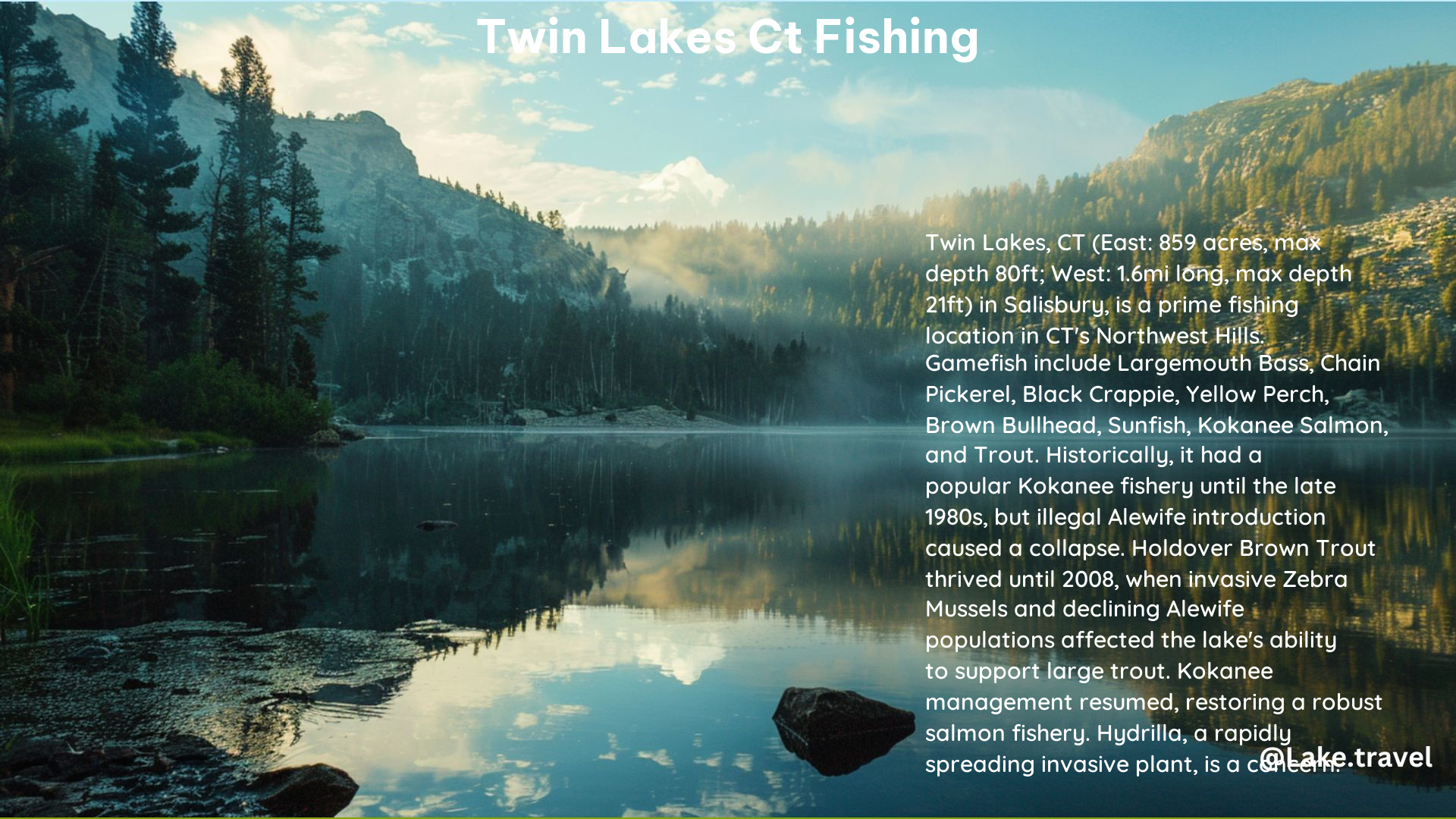Twin Lakes, located in Salisbury, Connecticut, is a premier fishing destination that offers a diverse array of fish species, including Trout, Salmon, Large and Small Mouth Bass, Pickerel, and Pan-fish. Spanning 859 acres, the lakes are regulated with a 3 water-skiers limit per boat and a 35 MPH limit, except for a 6 MPH limit within 200 feet of a vessel or dock, and from 1/2 hour after sunset to 1/2 hour after sunrise.
The History of East Twin Lake’s Fisheries Management
East Twin Lake, one of the Twin Lakes, has a rich history of fisheries management, with a focus on kokanee salmon fishery management since the late 1980s. However, the introduction of landlocked alewife in the late 1980s led to a collapse of the kokanee fishery due to competition for food. Zebra mussels were discovered in the lake in 1998, further complicating the lake’s biological dynamics and leading to the collapse of the alewife population and holdover brown trout by 2008. The Fisheries Division has since been stocking surplus kokanee salmon fry into the lake in hopes of reviving the population.
Fishing Forecast and Regulations

For those interested in fishing at Twin Lakes, the best times to go fishing can be found using Fishbrain, a platform that provides fishing forecasts, fishing spots, and regulations. Users can create a free account to access BiteTime™, a fishing forecast tool that predicts the best times to catch specific fish species.
The Twin Lakes are subject to various regulations to ensure sustainable fishing. These regulations include:
- 3 water-skiers limit per boat
- 35 MPH speed limit, except for a 6 MPH limit within 200 feet of a vessel or dock, and from 1/2 hour after sunset to 1/2 hour after sunrise
The Twin Lakes Association (TLA)
The Twin Lakes Association (TLA) is an organization that aims to protect and preserve the Twin Lakes as a freshwater resource and recreational area. The TLA provides information on lake happenings, including newsletters, photo contests, and annual meetings.
Fishing Spots and Techniques
Twin Lakes offers a variety of fishing spots and techniques for anglers to explore. Some popular fishing spots include:
- The Narrows: This area between the two lakes is known for its productive fishing, particularly for bass and pickerel.
- Coves and Inlets: The numerous coves and inlets around the lakes provide excellent habitat for a variety of fish species.
- Submerged Structures: Anglers can target fish around submerged structures, such as fallen trees and underwater ledges.
Effective fishing techniques at Twin Lakes include:
- Fly Fishing: The lakes’ clear waters and diverse fish populations make them an excellent destination for fly fishing enthusiasts.
- Baitcasting: Baitcasting rigs are well-suited for targeting larger fish, such as bass and pickerel.
- Spinning: Spinning rods and reels are versatile and can be used to target a wide range of fish species.
Seasonal Fishing Patterns
The fishing at Twin Lakes can vary throughout the year, with different species becoming more active and accessible during certain seasons. Here’s a general overview of the seasonal fishing patterns:
- Spring: Trout and salmon are the primary targets, as they become more active and feed aggressively during this time.
- Summer: Bass, pickerel, and pan-fish become the focus, as they thrive in the warmer waters.
- Fall: Trout and salmon once again become the primary targets as they prepare for spawning.
- Winter: Ice fishing for pan-fish, such as crappie and perch, can be productive during the colder months.
Conclusion
In summary, Twin Lakes in Salisbury, Connecticut, offers a diverse fish population and a rich history of fisheries management. With regulations in place to ensure sustainable fishing and platforms like Fishbrain to help plan fishing trips, Twin Lakes is an ideal destination for fishing enthusiasts. Whether you’re a fly fishing enthusiast, a baitcasting aficionado, or a spinning reel enthusiast, Twin Lakes has something to offer for every type of angler.
